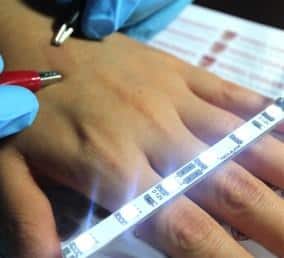
The film, described in the journal Advanced Materials, is conductive and transparent. It is manufactured by first electrospinning a nanofibre mat of polyacrylonitrile (PAN), where the fibres are about one-hundredth the diameter of a human hair. According to the researchers, the process shoots out the material like a rapidly coiling noodle, which when deposited on to a surface intersects itself a million times.
"The nanofibre spins out in a spiral cone, but forms fractal loops in flight," said Alexander Yarin, a professor of mechanical engineering at UIC and one of the paper’s lead authors. "The loops have loops, so it gets very long and very thin."
This structure also makes the material 92 per cent transparent. “Most of it is holes," said Yarin. "You don't see it."
To make the material conductive, it is spatter-coated with a metal so that it can attract metal ions. It is then electroplated, typically with copper, but alternatively with silver, nickel or gold. The researchers describe the result as a "self-junctioned copper nano-chicken wire" which is bendable and stretchable, and has potential for applications ranging from roll-up touchscreens, wearable electronics, flexible solar cells and electronic skin.
"We can then take the metal-plated fibres and transfer to any surface - the skin of the hand, a leaf, or glass," Yarin said.
Yarin’s co-lead on the paper is Prof Sam Yoon from Korea University. According to Yoon, the material has a "world-record combination of high transparency and low electrical resistance," with the latter property marking at least a 10-fold improvement on the previous record. The researchers claim both the electrospinning and electroplating take just a few seconds, making the process relatively high-throughput and commercially viable.




Poll: Should the UK’s railways be renationalised?
I think that a network inclusive of the vehicles on it would make sense. However it remains to be seen if there is any plan for it to be for the...